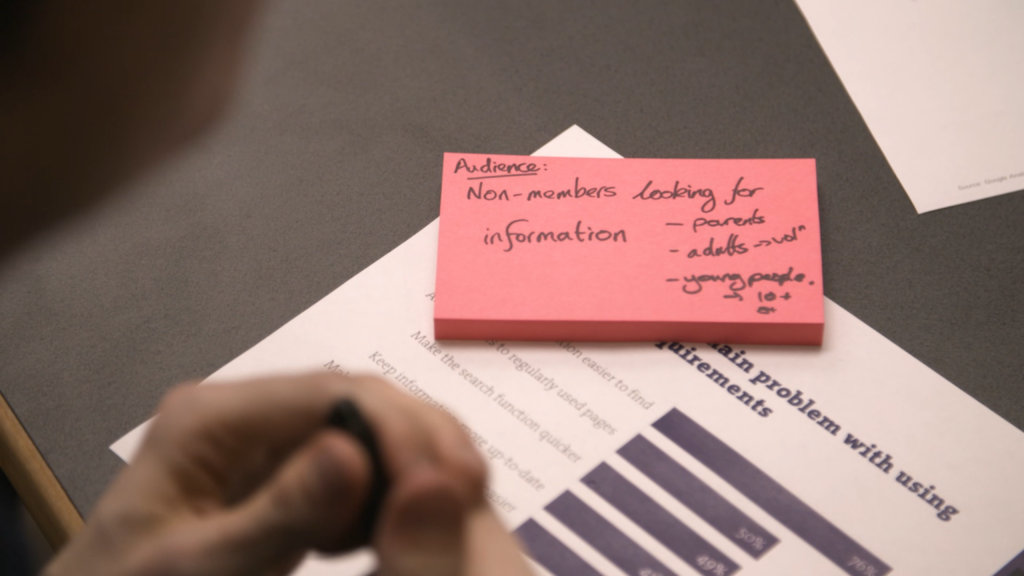Digital lessons from 2019

We’ve been working on changes to our website since 2018, developing a brand new site with a programme planning feature, improved navigation and a joined-up group finder experience.
We’ve learnt a lot in the process and, to welcome in the new year, we thought we would share some of our lessons with you.
*
Agile working is incredibly effective
To assist in the development of our web platform, we changed the way we worked. Traditional development often uses a methodology called waterfall, where software creation is broken up into a series of phases where each depends on the delivery of the last. This means that software can take longer to reach the user because it isn’t iterative.
Agile, however, focuses on a series of user stories, or desired experiences, to identify what features should be prioritised. By placing the user front and centre, functional software can be developed and user experience can be improved.
Using Agile meant we could:
- Work in fixed “sprints” to set feature development goals
- Have regular, timed meetings to showcase the previous week’s work, discuss lessons learned and generate future ideas
- Empower the team to own the creation, development and upkeep of individual features
- Iterate development to ensure features are released when ready rather than waiting for the whole project to complete
We’ve learnt that Agile is an incredibly powerful tool. It gives structure and focus to the creation of software and helps to break down projects into bite-sized chunks of features which can be released as they are completed. This, ultimately, helps to put the user at the heart of everything we do.
Going “Beta” invites everyone to improve your tools
One of the benefits of Agile development is the ability to release software part-way through its development. When a website is usable but there are features you’d like feedback on, releasing it in a “beta” stage helps to collect feedback from people outside the development team.
The feedback you have given us, on features such as our programme planner and group finder, has helped to shape their development. We’ve held dozens of webinars to discuss features, testing sessions to walk through user journeys and have strived to embed volunteer involvement at every stage of development. We’ve had almost 400,000 visitors to our site since its launch and received 4,380 individual pieces of feedback. Our tools have been improved immeasurably as a result.
We’ve found releasing our web platform in its “beta” stage to be one of the most effective elements of our new way of working, helping us to continuously measure, test, and learn.
One for the techies: going headless is complex but worthwhile
For our web platform, we wanted to create a mobile-first design that prioritised the user experience, using modern web technologies like Vue.js to create a reactive and responsive site. To fill it with content, we realised we were going to have to use what’s known as a headless CMS.
Beneath every website is a means to alter its content, called a Content Management System or CMS. They are often linked directly to the front-end or user interface of a website, like Wordpress, but those systems are often restricted by their developers and difficult to customise.
It is also difficult to link a custom user interface to those systems without creating a Frankenstein’s monster of a website, with the CMS servicing some pages and other, static pages being displayed to create a unique or modern feel. We didn’t want to do that - we wanted our users’ experience to be consistent so coupling Vue with a headless CMS, Umbraco, gave us that ability.
While “going headless” gave us the user experience we wanted, it also created problems due to the complex nature of its implementation. With Wordpress, there is one system to manage, one app to deploy. With a headless CMS, because it is detached from the user interface and the database as a separate entity, there is another system to manage. You have to have two environments which are kept in sync to ensure that functionality in one is mirrored in the other.
This proved particularly difficult for generating previews - something Umbraco does out of the box - because the CMS was not attached directly to the website. We had to adapt our working practices to achieve the functionality that would have otherwise come out of the box. We had to make sure our decision, driven by our desire to create the best user experience, was deliverable and manageable by our teams, too.
We’re very glad we persisted in implementing Umbraco, which makes it easier than ever before to manage and update a wide array of custom information across our web platform. We learnt a lot during this process, but the successful deployment has reinforced the lesson that what’s good for the user is, in the end, also good for our team.
*
We’re proud of what we’ve been able to deliver so far, and we’ve enjoyed learning and growing as an organisation during the course of our web platform’s development.
Looking to 2020, we’re excited about the prospect of following the major digital trends of this year by putting data centre stage. We’ve already started to gather analytics about our website, whether through our Feedback tool or through Google Analytics, but we’ll be looking to use this data to inform our development priorities in the future.
We look forward to working with you throughout 2020 to test and improve our web platform.